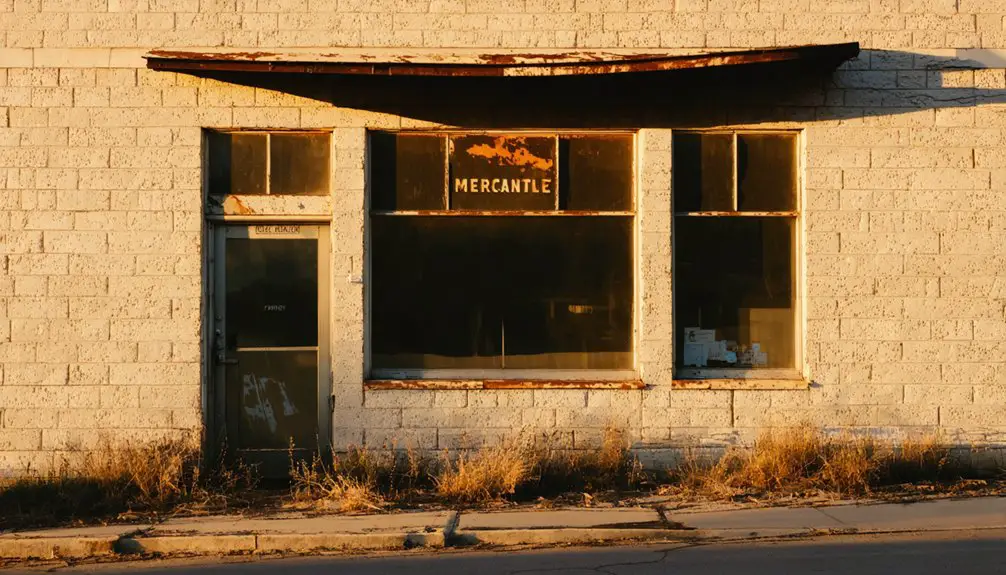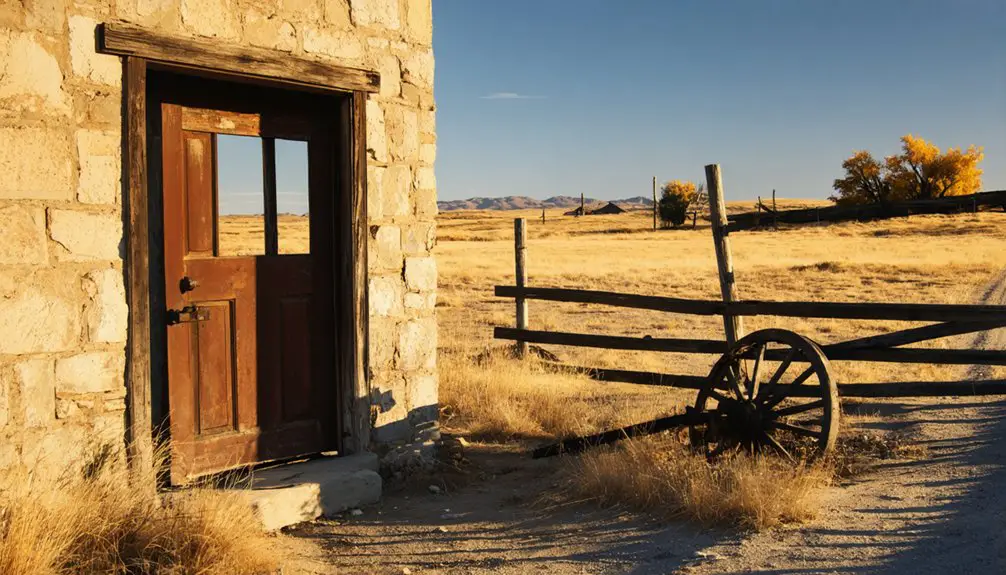You’ll find the remnants of Pawnee, Kansas’s territorial capital within Fort Riley Military Installation, where a dramatic five-day legislative session in July 1855 marked both the peak and downfall of this ambitious frontier town. Governor Andrew Reeder chose the location to limit pro-slavery influence, but the “Bogus Legislature” quickly abandoned it amid controversy and cholera. While most structures were demolished, the preserved capitol building and archaeological discoveries reveal a fascinating chapter of Kansas’s territorial struggles.
Key Takeaways
- Pawnee served as Kansas Territory’s capital for only five days in 1855 before being abandoned due to political conflicts.
- The town declined after Secretary of War Jefferson Davis ordered military forces to evict residents, incorporating the land into Fort Riley.
- A devastating Asiatic cholera outbreak contributed to the town’s rapid demise during its brief period as territorial capital.
- The original capitol building still stands as part of the Fort Riley Museum, serving as the last physical remnant of Pawnee.
- Military jurisdiction continues to control the former townsite, preventing civilian resettlement and preserving Pawnee’s ghost town status.
The Five-Day Capital of Kansas Territory
While many state capitals have moved throughout history, few had a tenure as brief as Pawnee, Kansas. You’ll find its historical significance rooted in the territorial period when it served as Kansas Territory’s capital for just five days, from July 2-6, 1855.
An outbreak of Asiatic cholera devastated the town during this period.
Governor Andrew Reeder chose this location deliberately, positioning it far from Missouri’s border to limit pro-slavery influence.
The pro-slavery legislature, known as the “Bogus Legislature,” wasn’t pleased with Pawnee’s remote location. They quickly unseated free-state delegates and passed a bill to move the capital to Shawnee Mission.
Despite Reeder’s veto, they overrode his decision, marking the end of Pawnee’s brief tenure.
Under the direction of Secretary of War Davis, the town of Pawnee was later destroyed to make way for Fort Riley.
Today, you can visit the original capitol building, now a museum within Fort Riley, as the only remaining structure of this ghost town.
A Building Born in Controversy
As tensions mounted in Kansas Territory during 1855, the construction of Pawnee’s capitol building became a flashpoint of controversy.
You’ll find the building’s controversial origins deeply rooted in Governor Andrew Reeder‘s personal interests – he owned shares in the town company and held significant land investments in Pawnee. His decision to locate the territorial legislature there sparked immediate backlash. President Pierce saw this as a serious misstep and removed from office Reeder.
Governor Reeder’s stake in Pawnee and its town company drove his self-serving decision to establish the territorial legislature there.
The political implications proved explosive. Pro-slavery legislators, already suspicious of Reeder’s motives, bristled at the building’s location. The site needed proper disambiguation of Pawnee to distinguish it from other similarly named locations.
Though locally sourced materials and labor went into constructing the stone edifice, its legitimacy was questioned from the start. When the “Bogus Legislature” convened, they swiftly voted to abandon the site, overriding Reeder’s veto and leaving the building’s grand purpose unfulfilled after just five days.
Political Power Struggles and Territorial Tensions
The political storm that engulfed Pawnee extended far beyond the disputed capitol building.
You’ll find that political manipulation ran deep, as pro-slavery legislators, many fraudulently elected, challenged Governor Reeder’s authority at every turn.
When Reeder established Pawnee as the capital, hoping to protect Kansas’s territorial integrity from Missouri’s influence, the pro-slavery faction fought back.
The legislature’s swift move to Shawnee Mission, closer to Missouri’s border, demonstrated their true intentions.
They’d arrive in Pawnee ready to camp, never planning to stay.
Their power grab included naming eastern Kansas counties after pro-slavery advocates, while Secretary of War Jefferson Davis‘s order to incorporate Pawnee into Fort Riley sealed the town’s fate.
Life After the Legislature’s Departure
Following Pawnee’s brief five-day stint as territorial capital in July 1855, swift and devastating changes transformed the once-promising settlement into a ghost town.
Secretary of War Jefferson Davis’s survey and President Pierce’s subsequent eviction order sealed the town’s fate, leading to widespread economic hardship as homes and businesses were demolished.
Today, visitors can see the old territorial capitol building which remains as one of the few preserved structures from Kansas’ early history.
You’ll find these dramatic events reshaped Pawnee forever:
- Major Cook deployed 1,000 Texas troops to forcefully evict resistant residents
- Military control tightened as Fort Riley absorbed the town’s lands, preventing any chance of civilian resettlement
- The destruction was complete – even the Governor’s Mansion fell to demolition crews
The land where Pawnee once stood remains under military jurisdiction today, with no structures surviving to mark its short-lived glory as Kansas Territory’s first capital. Like many Kansas settlements, including the once-thriving town of Ash Valley that saw its bank liquidated during the Depression, Pawnee’s economic decline proved irreversible.
From Bustling Town to Historical Site
When you look at Pawnee’s dramatic transformation, you’ll find a town that rose to territorial prominence and fell from power within mere days of July 1855.
You can trace the town’s swift decline to Secretary of War Jefferson Davis‘s order for its destruction, which came shortly after the legislature abandoned the site for Shawnee Mission.
While the original settlement vanished into ghost town status, Pawnee’s restored territorial capitol building stands today as part of the Fort Riley Museum, preserving the brief but significant moment when Kansas Territory’s political future hung in the balance. The region’s military presence was later strengthened with the establishment of Fort Larned in 1859. The town’s brief five-day tenure as the first Kansas capital marked a pivotal chapter in the territory’s early history.
Rapid Rise and Fall
Pawnee’s dramatic transformation from territorial capital to ghost town stands as one of Kansas’s swiftest municipal declines.
After just five days as the territorial seat in 1855, the fraudulently-elected pro-slavery legislature abandoned the town, triggering an irreversible economic decline.
You’ll find that this rapid desertion left newly-built boarding houses empty and the capital building investment wasted.
- The “Bogus Legislature” undermined Governor Reeder’s free-state vision by relocating the capital to Shawnee Mission, over 100 miles away.
- Fort Larned’s establishment in 1859 drew settlers and military focus from Pawnee.
- Without railroads or industry to sustain it, Pawnee quickly faded while surrounding towns flourished with schools, fairs, and churches.
The area held spiritual significance for Native Americans, as the Pa-hur rock marked one of five sacred sites where the Pawnee people made offerings to Ti-ra-wa.
Today, you’ll find only remnants and historical markers where this ambitious capital once stood.
Town’s Lasting Historical Legacy
Three significant legacies endure from Pawnee’s brief existence as Kansas Territory’s capital.
First, you’ll find the original capitol building, restored in 1928 by Union Pacific Railroad, now serving as the Fort Riley Museum.
Second, the area’s historical significance lives on through the Pawnee Indian Museum, Kansas’ first State Historic Site, where you can explore archaeological findings from a late 1700s Native American village. The museum’s immersive exhibits feature earth lodge remnants preserved in their original location since the late 18th century.
Finally, you’ll discover how Pawnee’s political drama during its five-day reign as territorial capital symbolizes the larger conflicts that led to the Civil War.
The town’s preservation efforts, including the museum built over an unexcavated earth lodge in 1967, continue to provide valuable insights into Kansas’ territorial period and Native American history.
Legacy of the “Bogus Legislature”
The notorious Bogus Legislature of 1855 left an indelible mark on Kansas Territory’s path to statehood, igniting tensions that would eventually erupt into “Bleeding Kansas.”
The Bogus Legislature of 1855 set Kansas ablaze with conflict, planting seeds that would grow into violent territorial bloodshed.
Through fraudulent elections orchestrated by thousands of pro-slavery Missourians who crossed the border to vote illegally, this legislature secured 34 of 35 seats and quickly established a framework of discriminatory laws that criminalized anti-slavery speech, disenfranchised local voters, and protected slave ownership.
The legislature’s brief five-day session in Pawnee reflected deeper struggles over territorial governance:
- You’d have witnessed Governor Reeder’s futile attempts to maintain control through vetoes.
- You’d have seen the hasty move to Shawnee Mission to consolidate pro-slavery power.
- You’d have observed how bogus legislation sparked the formation of a rival free-state government.
Regional Landmarks and Hidden Treasures

Among Kansas Territory’s most compelling historic sites, two landmarks stand as evidence to the region’s rich cultural heritage: the meticulously preserved Pawnee Indian Museum and the iconic Pawnee Rock State Historic Site.
At the Pawnee Museum, you’ll discover an excavated 1820s lodge with in-situ artifacts, including tools, pottery shards, and a bison skull that tell the story of Native American life.
Meanwhile, Pawnee Rock offers you a commanding 360-degree view of the Arkansas River Valley from its sandstone summit. This natural fortress, though smaller now due to settlers’ quarrying, served as an essential waypoint for Santa Fe Trail travelers.
You can still trace history in the nearby Ash Creek wagon ruts while exploring the rolling prairie landscape that surrounds these remarkable landmarks.
Frequently Asked Questions
What Was the Population of Pawnee During Its Peak?
You’ll find that Pawnee’s peak population reached around 1,000 residents during its historical significance as a mining town, complete with churches, hotels, bars, brothels, and brief status as territorial capital.
Are There Any Remaining Original Artifacts From the Capitol Building?
You won’t find any verified original artifacts from 1855 inside the Capitol. While the building’s preserved for its historical significance, today’s furnishings are period-appropriate replacements purchased during restoration efforts.
How Much Did Land Cost in Pawnee During 1855?
While you’d expect clear records of land value from this historically significant period, you can’t find exact Pawnee prices since the military-controlled land wasn’t freely sold on the open market.
Can Visitors Access the Pawnee Site at Fort Riley Today?
You can’t directly access Pawnee’s site today since it’s within Fort Riley’s military base. While you’ll need security clearance to enter the fort, historical preservation efforts include occasional ghost tours.
Were There Any Businesses or Industries Operating in Pawnee?
You’ll find Pawnee businesses included two general stores, coal mining operations, a hotel, and merchants like Godfrey Coal & Mining Company. Railroads supported these industries during the town’s early development.
References
- https://en.wikipedia.org/wiki/Pawnee
- https://kids.kiddle.co/Pawnee
- https://www.legendsofamerica.com/pawnee-rock-treasure/
- https://www2.ljworld.com/news/2011/apr/15/little-remains-defunct-pawnee-county-ghost-town/
- https://en.wikipedia.org/wiki/First_Territorial_Capitol_of_Kansas
- https://civilwaronthewesternborder.org/map/pawnee-kansas
- https://legendsofkansas.com/pawnee-capitol/
- http://www.thecivilwarmuse.com/index.php?page=first-territorial-capitol-of-kansas
- https://jocohistory.wordpress.com/2021/07/11/kansas-territorial-history-governor-andrew-reeder/
- https://www.pawneecountykansas.com/211/About-Pawnee-County



